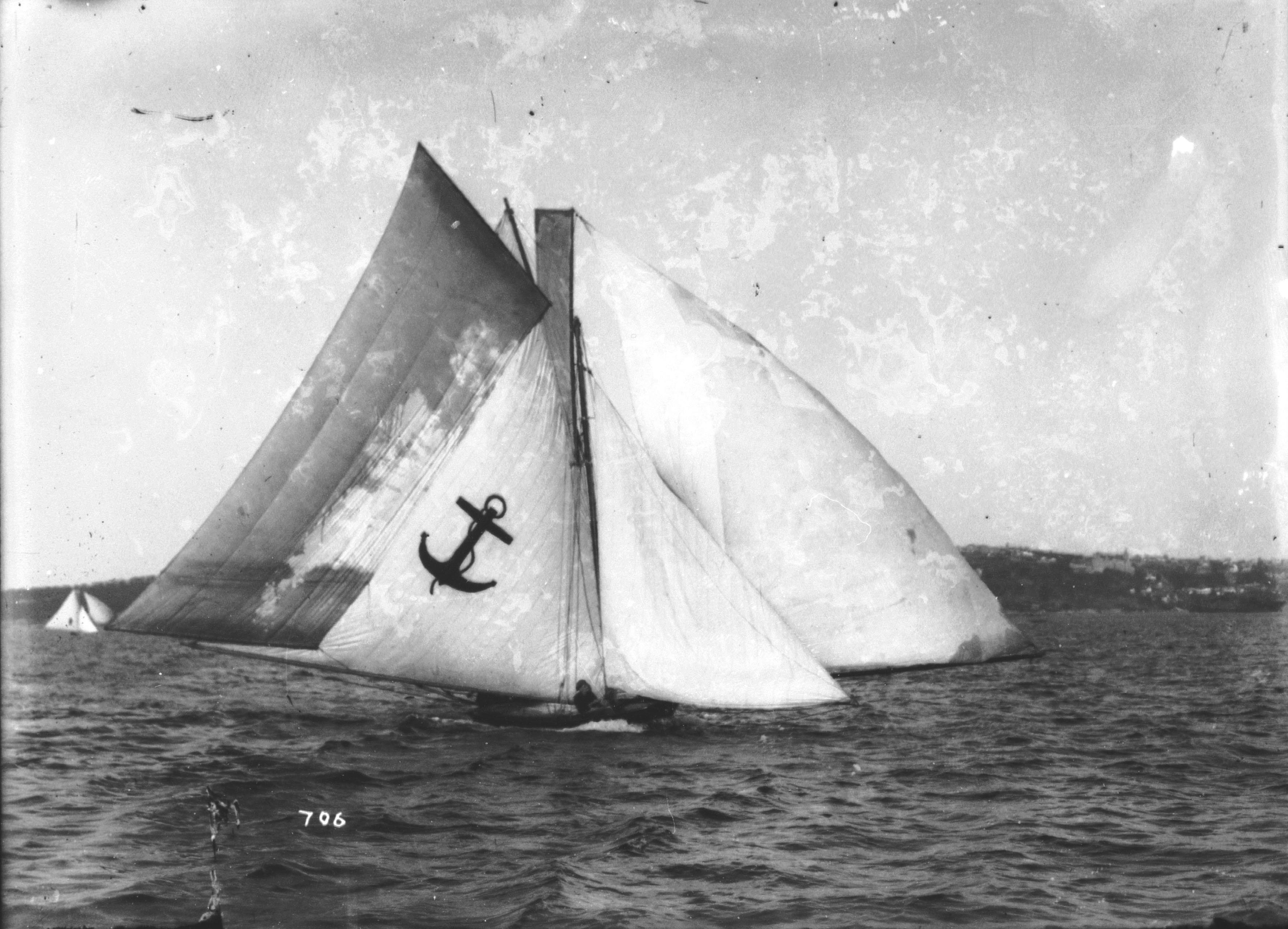
Simple stuff: 4 x 18 feet = 72 feet.
72 feet x 1/3.281 = about 22 metres (in French).
But if you put the four 18-foot skiffs currently on display at the museum in a line, their long bowsprits and booms make the line closer to 120 feet or 37 metres long. Imagine this impressive sight as their big rigs tower over the 5.5-metre long hulls.
Enough maths! In a rare opportunity, the museum has four classic 18s on display at once. Britannia, Yendys and Taipan have been visited by the replica of Myra Too, the quartet covering a wide section of the 18-foot skiffs’ colourful class history.

Britannia – William Hall Collection – ANMM
Britannia makes a terrific starting point. It has a big eight-foot (2.45-metre) wide hull, seam batten planked in Queensland cedar, strong thwarts and tabernacle—everything that these mighty craft began with in the 1890s as open boats racing with Mark Foy’s Sydney Flying Squadron. It was built in 1919 by the legendary ‘Wee Georgie’ Robinson. ‘Wee Georgie’ and his team from Balmain raced Britannia hard and its career spanned the next few generations of gradual developments until it retired after World War II. In that time it carried one of the largest rigs ever put on an 18. That rig was rebuilt when the vessel was restored in the late 1980s and is how it is displayed in the Watermarks exhibition at the museum.
As we walk into the Wharf 7 foyer, on our right is Sydney Heritage Fleet’s Yendys. A rival of Britannia, Yendys was built in 1925 by Charlie Hayes for Norm Blackman. This big hull is also built in the traditional heavy scantlings, but it illustrates an early piece of innovation, its transom bow. Hayes had another legend working for him at the time, Charlie Peel, who had been successful with transom bows on 14-foot skiffs in Victoria. As well, the 1920s was the time when the Restricted 21s showed how fast a lighter-keel boat could go, and Hayes and Peel were in the thick of this class too. Out comes Yendys, with its sawn-off profile and veed bow shapes, a sort of restricted-class yacht crossed with a skiff and with the bow overhang squared off. Despite the odd mix it went pretty well too, but although another two snub-nosers were built in that time, the idea did not catch on. It did show there was room to move in the rules, though, and the Queenslanders took on both innovation and the establishment at the same time.

Yendys – William Hall Collection – ANMM
The 1930s ‘galloping ghost’ from Queensland, Aberdare, was a narrow seven-foot (2.15 metre) beamer that won many races and championships. It was so unpopular with traditional sailors that two new clubs were set up that allowed seven-foot beamers to race – the New South Wales 18-Foot Sailing League and the Brisbane 18-Foot Sailing Club – and the politics spawned by that divide raged on for decades.
Six feet (1.83 metres) became the new seven feet in the 1940s. Sailing in the 1951 season, Billy Barnett and Myra Too from the Sydney Flying Squadron won everything – states, nationals, worlds – the lot. The Myra Too replica, sitting on its rigging cradle on the Wharf 7 floor, and built a little differently from the original, is still a showcase of how the lighter construction had taken hold of the class post-war, finally shutting the door to the big-boat era of Britannia and Yendys.
The new boats were planing, the crew were swinging out on trapezes, and just when they thought they were the bees’ knees of skiff and dinghy sailing, along came Bob Miller and the plywood Taipan in 1959. This was another Queensland revolution that caused heartache and resistance in New South Wales but became the origins of today’s flyers. Here it is, elevated for all to see the end plates and fences on the appendages – the things that led Bob Miller, who had by then changed his name to Ben Lexcen, to the controversial features on Australia II that ultimately helped snare yachting’s greatest trophy, the America’s Cup, in 1983. Taipan was rebuilt in 2007 to its 1959 configuration that caused as much local stir in its own time, even though it only won a few races and had many gear failures. When it worked, it often won with big margins. Taipan had the speed and performance that the crews wanted, and they never looked back.

Taipan – Courtesy Robin Elliot
To complete this, but not on display, the ANMM collection also has a 1970s Bruce Farr design, KB, the type that bedded down the three-hander, and then Colorbond, from 1985/86, a showcase of where it all went ballistic. Getting back to numbers here, the 18-foot skiffs sported bowsprits and extensions that made them around 40 feet (12 metres) long and more than 20 feet (six metres) wide and enabled them to do powerboat speeds on the harbour—and the cost of all this yearly high-tech building spree finally blew the lid on development in the class.
The skiffs on display are three survivors rebuilt to their former glory and a fourth built as a replica to race on and carry the heritage of the class into the future. Did the four skiffs on display ever sail on the harbour together? Not likely, but in a lovely moment captured on film, we have the original Myra Too running downwind to eventually pass the seven-foot beamer Jantzen Girl that’s just in front, and there off to the side is a little motor launch with a mast—it looks like it could be Britannia which was converted by ‘Wee Georgie’ to be the club’s starting boat—and it’s trying hard on one cylinder to keep up with progress.

Myra Too – Bill Barnett Collection – ANMM
